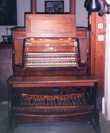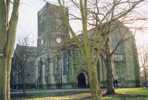For this church:    |
| |||||||||||||||||||||||||||||||||||||||||||||||||||||||||||||||||||||||||||||||||||||||||||||||||||||||||||||||||||||||||||||||||||||||||||||||||||||||||||||||||||||||||||
 The
1901 organ The
1901 organabove the Lady Chapel screen |
 The
console in The
console inits present location |
In 1901, the then organist Mr C F Hole, proposed a scheme costing £350 to move the 1872 organ and console from the chancel to a new position above the screen dividing the Lady Chapel from the nave. The cost was kept to a minimum by the church users carrying out much of the work. A green and gold panelled Gothic style screen was constructed topped with the organ pipes, almost filling the arch. The access to the console necessitated the organist ascending a narrow iron spiral staircase through a door set in the corner of the South vestry. The rather low entrance leading from the top of the stairs onto the walkway over the screen to the organ can still be seen but is blocked by a substantial piece of timber.
At the time of the move the church was lit by gas. It is reported that ‘the organist was nearly suffocated by the rising fumes’ so the console had to be lowered to its present position to the right hand side at the front of the Lady Chapel screen. The consequent patching of the organ screen is evidence of the move.
The instrument was rebuilt and enlarged as part of the move from the chancel, this work being carried out by Cousans and Sons of Lincoln. The specification listed at the 1901 re-opening was:
Great Organ - Compass CC to g'' 56 |
|||
| 1 Lieblich Bourdon | 16 feet | ||
| 2 Open Diapason I | 8 feet | ||
| 3 Open Diapason II | 8 feet | ||
| 4 Gamba | 8 feet | ||
| 5 Hohl Flote | 8 feet | ||
| 6 Principal | 4 feet | ||
| 7 Fifteenth | 2 feet | ||
| 8 Trumpet | 8 feet | ||
Swell Organ - Compass CC to g'' 56 |
|||
| 9 Double Diapason | 16 feet | ||
| 10 Violin Diapason | 8 feet | ||
| 11 Orchestral Gamba | 8 feet | ||
| 12 Vox Angelica | 8 feet | ||
| 13 Vox Celeste | 8 feet | ||
| 14 Principal | 4 feet | ||
| 15 Mixture | III ranks | ||
| 16 Horn | 8 feet | ||
| 17 Oboe | 8 feet | ||
| 18 Vox Humana | 8 feet | ||
Choir Organ - Compass CC to g'' 56 |
|||
| 19 Salicional | 8 feet | ||
| 20 Gedecht | 8 feet | ||
| 21 Dulciana | 8 feet | ||
| 22 Harmonic Flute | 4 feet | ||
| 23 Clarinet | 8 feet | ||
Pedal Organ CCC to F 30 |
|||
| 24 Open Diapason | 16 feet | ||
| 25 Bourden | 8 feet | ||
| 26 Bass Flute | 16 feet | ||
Couplers |
|||
| 27 Swell Super Octave | |||
| 28 Swell to Choir | |||
| 29 Swell to Choir | |||
| 30 Choir to Great | |||
| 31 Swell to Pedals | |||
| 32 Choir to Pedals | |||
| 33 Great to Pedals | |||
Tremulant by a pedal
Four Composition Pedals to Great Organ
Four Composition Pedals to Swell Organ
Blown by detached Feeders and Melvin Hydraulic Engine
The whole of the action, couplers etc., are by the builders Tubular Pneumatic System.
The keyboards, stops knobs at an angle of 45 degrees, pedal board and positions generally are in accordance with the suggestions of the Royal College of Organists London
Currently the console is housed in a plain oak case said to have been designed by Bodely (?) A plate attached to the console bears the name of a local organ builder E Wragg and Sons and is of the style of the 1920s/1930s, possibly a date when the organ was again repaired. Currently the organ is not in use having been declared unsuitable for playing and beyond economic repair.
 The
small organ The
small organ |
A smaller organ is used for services. This is located under the arch of the North transept and is on loan to the church from Mr David Bloodworth. It is a much older instrument than its more permanent companion having been built between 1820 and 1850 by Samuel Parsons of Bloomsbury Square London. It is known that at one time it was located in a church at Toddington (just off the M1 motorway), before being bought to Nottingham where it has seen service at All Souls’ Church Radford and St Mary’s in the Lace Market before its current resting place. It has a plain case which has been painted white.
A grand piano is also used in the church.






